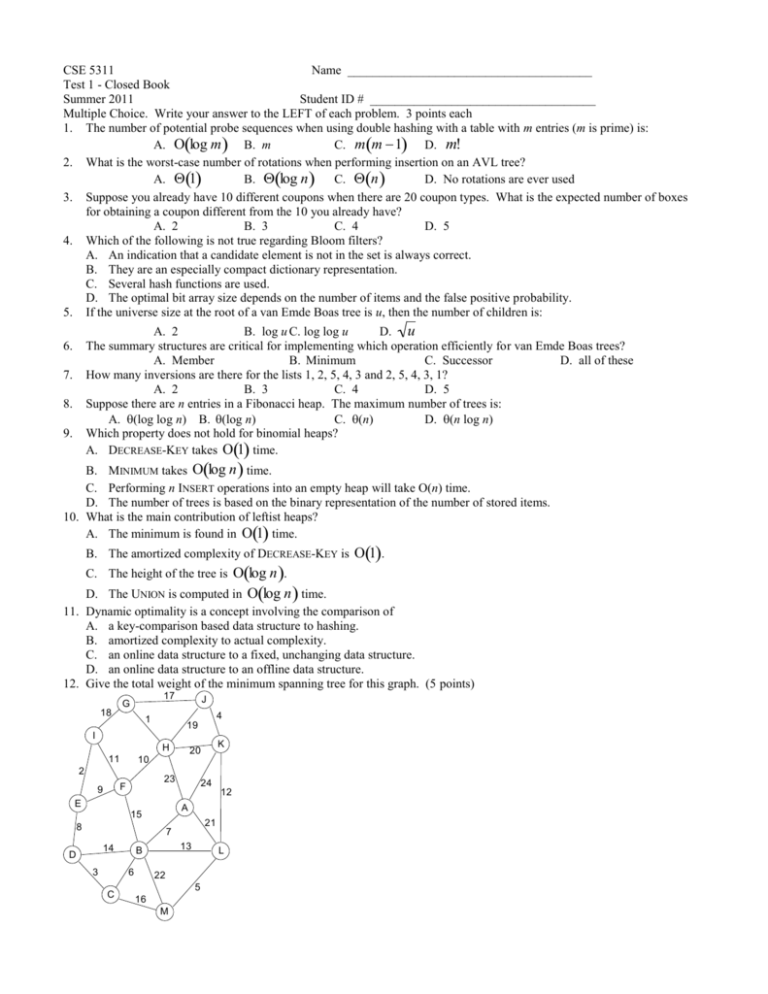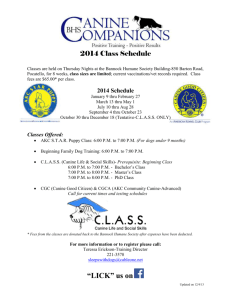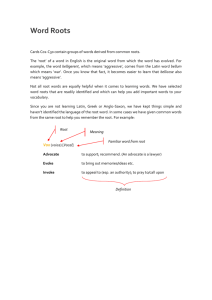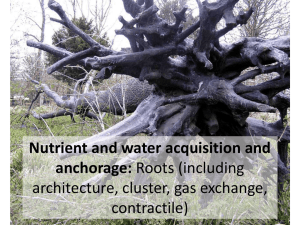doc
advertisement

CSE 5311
Name _______________________________________
Test 1 - Closed Book
Summer 2011
Student ID # ____________________________________
Multiple Choice. Write your answer to the LEFT of each problem. 3 points each
1. The number of potential probe sequences when using double hashing with a table with m entries (m is prime) is:
A. log m B. m
C. m m 1 D. m!
2. What is the worst-case number of rotations when performing insertion on an AVL tree?
A. 1
B. log n
C. n
D. No rotations are ever used
3. Suppose you already have 10 different coupons when there are 20 coupon types. What is the expected number of boxes
for obtaining
a coupon different from the
10 you already have?
A. 2
B. 3
C. 4
D. 5
4. Which
of
the
following
is
not
true
regarding
Bloom
filters?
A. An indication that a candidate element is not in the set is always correct.
B. They are an especially compact dictionary representation.
C. Several hash functions are used.
D. The optimal bit array size depends on the number of items and the false positive probability.
5. If the universe size at the root of a van Emde Boas tree is u, then the number of children is:
A. 2
B. log u C. log log u
D. u
The summary structures are critical for implementing which operation efficiently for van Emde Boas trees?
A. Member
B. Minimum
C. Successor
D. all of these
How many inversions are there for the lists 1, 2, 5, 4, 3 and 2, 5, 4, 3, 1?
A. 2
B. 3
C.
D. 5
4
Suppose there are n entries in a Fibonacci heap. The maximum number of trees is:
A. (log log n) B. (log n)
C. (n)
D. (n log n)
Which property does not hold for binomial heaps?
A. DECREASE-KEY takes 1 time.
6.
7.
8.
9.
B. MINIMUM takes log n time.
C. Performing n INSERT operations into an empty heap will take O(n) time.
D. The number of trees is based on the binary representation of the number of stored items.
contribution of leftist heaps?
10. What is the main
A. The
minimum is found in 1 time.
B. The amortized complexity of DECREASE-KEY is 1.
C. The height of the tree is log n .
D. The UNION is
computed in log n time.
11. Dynamic optimality is a concept involving the comparison of
A. a key-comparison based data structure to hashing.
B. amortized complexity
to actual complexity.
C. an online data structure
to a fixed, unchanging data structure.
D. an online data structure to an offline data structure.
12. Give the total weight of the minimum spanning tree for this graph. (5 points)
18
17
G
J
4
1
19
I
H
11
2
23
F
9
24
12
E
A
15
8
21
7
14
D
3
13
B
6
C
K
20
10
L
22
5
16
M
2
13. Give an example of a binary search tree that can be colored as a legal red-black tree, but does not satisfy the AVL balance
conditions. (6 points)
14. Give the binomial (min) heap that results from inserting 1, 2, 3, 4, 5, 6, 7, 8 (in that order) into an empty heap. (6 points)
CSE 5311
Name _______________________________________
Test 1 - Open Book
Summer 2011
Student ID # ____________________________________
1. The hash table below was created using double hashing with Brent’s rehash. The initial slot ( h1key ) and rehashing
increment ( h2 key) are given for each key. Show the result from inserting 7095 using Brent’s rehash when
h1(7095) 4 and h2 (7095) 4 . (10 points)
h1key h2 key
key
0
1
2
3
4
5
6
7000
7081
7002
7004
7006
0
4
2
5
2
1
4
3
6
5
key
0
1
2
3
4
5
6
2.
a.
b.
c.
3.
Evaluate the following recurrences using the master method. (10 points)
T n T 0.7n n
T n T 0.7n 1
T n 16T n n 3
2
Construct the final optimal binary search tree (using Knuth’s root trick) and give its cost. SHOW YOUR WORK. (10
points)
n=6;
q[0]=0.01;
key[1]=10;
p[1]=0.19;
q[1]=0.02;
key[2]=20;
p[2]=0.1;
q[2]=0.03;
key[3]=30;
p[3]=0.2;
q[3]=0.04;
key[4]=40;
p[4]=0.2;
q[4]=0.0;
key[5]=50;
p[5]=0.02;
q[5]=0.04;
key[6]=60;
p[6]=0.12;
q[6]=0.03;
w[0][0]=0.010000
w[0][1]=0.220000
w[0][2]=0.350000
w[0][3]=0.590000
w[0][4]=0.790000
w[0][5]=0.850000
w[0][6]=1.000000
w[1][1]=0.020000
w[1][2]=0.150000
w[1][3]=0.390000
w[1][4]=0.590000
w[1][5]=0.650000
w[1][6]=0.800000
w[2][2]=0.030000
w[2][3]=0.270000
w[2][4]=0.470000
w[2][5]=0.530000
w[2][6]=0.680000
w[3][3]=0.040000
w[3][4]=0.240000
w[3][5]=0.300000
w[3][6]=0.450000
w[4][4]=0.000000
w[4][5]=0.060000
w[4][6]=0.210000
w[5][5]=0.040000
w[5][6]=0.190000
w[6][6]=0.030000
Building c(0,2) using
thru 2
Building c(1,3) using
thru 3
Building c(2,4) using
thru 4
Building c(3,5) using
thru 5
Building c(4,6) using
thru 6
Building c(0,3) using
thru 3
roots 1
roots 2
roots 3
roots 4
roots 5
roots 1
2
Building c(1,4)
using roots
3 thru 3
Building c(2,5)
using roots
3 thru 4
Building c(3,6)
using roots
4 thru 6
Building c(0,4)
using roots
2 thru 3
Building c(1,5)
using roots
3 thru 4
Building c(2,6)
using roots
4 thru 4
Building c(0,5)
using roots
3 thru 3
Building c(1,6) using roots 3
c(1,3) cost 0.540000 30(20,)
thru 4
c(2,4) cost 0.710000 30(,40)
Building c(0,6) using roots ?
c(3,5) cost 0.360000 40(,50)
thru ?
c(4,6) cost 0.270000 60(50,)
Counts - root trick 29 without
c(0,3) cost 1.080000 20(10,30)
root trick 50
c(1,4) cost 0.980000 30(20,40)
Average probe length is ????
c(2,5) cost 0.860000 40(30,50)
trees in parenthesized prefix
c(3,6) cost 0.720000 40(,60(50,))
c(0,0) cost 0.000000
c(0,4) cost 1.530000
c(1,1) cost 0.000000
30(10(,20),40)
c(2,2) cost 0.000000
c(1,5) cost 1.160000
c(3,3) cost 0.000000
30(20,40(,50))
c(4,4) cost 0.000000
c(2,6) cost 1.220000
c(5,5) cost 0.000000
40(30,60(50,))
c(6,6) cost 0.000000
c(0,5) cost 1.710000
c(0,1) cost 0.220000 10
30(10(,20),40(,50))
c(1,2) cost 0.150000 20
c(1,6) cost 1.610000
c(2,3) cost 0.270000 30
40(30(20,),60(50,))
c(3,4) cost 0.240000 40
c(0,6) cost ????????
c(4,5) cost 0.060000 50
??????????????
c(5,6) cost 0.190000 60
c(0,2) cost 0.500000 10(,20)
4. Fill in the min and max blanks for the following instance of a van Emde Boas tree for the set {1, 8, 9, 10, 12, 13, 14}.
You should give these as values in the local universe (0..u-1). Instead of using the symbol “/” for NIL, use the symbol
“”. (10 points)
root (base 0) u 16 min _______ max _______
summary (base 0) u 4 min _______ max _______
summary (base 0) u 2 min _______ max _______
cluster[0] (base 0) u 2 min _______ max _______
cluster[1] (base 2) u 2 min _______ max _______
cluster[0] (base 0) u 4 min _______ max _______
summary (base 0) u 2 min _______ max _______
cluster[0] (base 0) u 2 min _______ max _______
cluster[1] (base 2) u 2 min _______ max _______
cluster[1] (base 4) u 4 min _______ max _______
summary (base 0) u 2 min _______ max _______
cluster[0] (base 4) u 2 min _______ max _______
cluster[1] (base 6) u 2 min _______ max _______
cluster[2] (base 8) u 4 min _______ max _______
summary (base 0) u 2 min _______ max _______
cluster[0] (base 8) u 2 min _______ max _______
cluster[1] (base 10) u 2 min _______ max _______
cluster[3] (base 12) u 4 min _______ max _______
summary (base 0) u 2 min _______ max _______
cluster[0] (base 12) u 2 min _______ max _______
cluster[1] (base 14) u 2 min _______ max _______
Give the range of possible heights for a red-black tree with 200 keys. Your answer should be two natural numbers giving the
minimum and maximum heights. (A tree with one node has height 0.) Show your work! (10 points)
CSE 5311
Name ________________________________
Test 2 - Closed Book
Summer 2011
Last 4 Digits of Student ID # ___________________________
Multiple Choice. Write your answer to the LEFT of each problem. 3 points each
1. When performing selection in worst-cast linear time for n numbers, roughly how many column medians are computed in
the first round?
A.
W n
5
B. m, the median-of-medians
C. .7n
4
D.
2.
3.
4.
5.
6.
7.
8.
9.
10.
11.
12.
13.
n
5
What is the nature of the signature function for the Karp-Rabin method?
A. the remainder by discarding the overflow for a polynomial
B. it is similar to the KMP failure links
C. similar to a double hash function for string keys
D. a polynomial of arbitrary precision implemented using a bignum package
Which of the following is helpful if you wish to know the farthest pair in a set of points in 2D?
A. Euclidean minimum spanning tree
B. Delaunay triangulation
C. Convex hull
D. Voronoi diagram
Which of the following is not a goal for suffix array construction methods?
A. Fast in practice
B. Based on radix sort
C. Lightweight
D. Linear-time in worse case
In a maximum flow problem, the number of augmenting paths in a flow decomposition is bounded by:
A. V
B. VE
C. f
D. E
Which algorithm is defined using the notions of left-turn and right-turn?
A. Graham scan
B. Closest points in 2-d space
C. Suffix array construction
D. Jarvis march
What data structure is used for the sweep-line status when computing the 2-d closest pair?
A. BST of points with y-coordinates as the key
B. Interval tree
C. BST of points with x-coordinates as the key
D. Sorted array by ascending x-coordinates
The four russians’ concept is to:
A. Pack bits into an efficient storage unit
B. Trade-off between enumerating situations and referencing these situations
C. Implement longest common subsequences using linear space
D. Trade-off between scalar additions and multiplications
When coloring the edges of a graph, a dc-path gets inverted because:
A. All edges in the fan will be colored with d or c.
B. d is a free color for all fan vertices.
C. d is the free color for two fan vertices.
D. We are trying to minimize the number of colors used by the path.
How many times will -1 occur in the style 2 fail link table for the pattern abacabac?
A. 1
B. 2
C. 3
D. 4
How many times will -1 occur in the style 1 fail link table for the pattern abacabac?
A. 1
B. 2
C. 3
D. 4
Which of the following problems is NP-complete? (Assume P NP)
A. 3-satisfiability
B. Testing if a graph is 2-colorable
C. Testing if a table is in sorted order
D. Verifying a solution to traveling salesperson
Which of the following is a deficiency of the maximum capacity path technique?
A. Augmenting paths will be discovered in descending incremental flow increase order.
5
B. Flow decomposition must be applied.
C. An augmenting path is blocked if it introduces a cycle of flow.
D. The maximum number of potential augmenting paths depends on the achievable flow, in addition to the number of
vertices and edges.
14. Constructing a suffix array for a sequence with n symbols by using an optimal key-comparison sort has this worst-case
time:
A. n
B. n log n
2
C. n
2
D. n log n
15. Which of the following does not have a polynomial-time approximation algorithm?
A. Bin packing
B. Edge coloring
with triangle inequality
C. Traveling
salesperson
D. Vertex coloring
16. Determine a monotone longest increasing subsequence for the sequence below. (5 points)
1
4
3
2
3
4
3
6
3
4
CSE 5311
Name ________________________________
Test 2 - Open Book
Summer 2011
Last 4 Digits of Student ID # ___________________________
1. Fill in the blanks in the following instance of a suffix array with lcp values and ranks. As usual, s[21] is NULL (‘\0’).
(15 points)
i
sa suffix
lcp s rank lcp[rank]
0
21
-1 0 __
__
1
20 0
0
1 __
__
2
7
00100101001010
1
0 __
__
3
15 001010
4
0 __
__
4
2
0010100100101001010
6
1 20
4
5
10 00101001010
9
0 7
3
6
18 010
1
1 15
2
7
5
0100100101001010
3
0 2
__
8
13 01001010
6
0 10
__
9
0
010010100100101001010
8
1 18
__
10 ___ 0100101001010
11 0 5
9
11 16 01010
3
0 13
8
12 3
010100100101001010
5
1 21
7
13 11 __101001010
8
0 8
6
14 19 __0
0
1 16
5
15 6
100100101001010
2
0 3
4
16 14 1001010
5
0 11
3
17 1
10010100100101001010
7
1 19
2
18 9
100101001010
10 0 6
1
19 ___ 1010
2
1 14
0
20 4
10100100101001010
4
0 1
0
21 12 101001010
7
0
-1
2. List the lift and push operations to solve for the maximum flow. In addition, give a minimum cut. (15 points)
a
3
4
1
s
b
2
t
c
2
5
d
1
2
e
3. Give the result of the Z algorithm and both KMP methods for the following sequence. (20 points)
0 a
6
1 c
2 a
3 b
4 a
5 c
6 a
7 c
8 a
9 b
10 a
11 c
12 a
13 b
14 a
15 c
16 a
17 c
18 a
19 b
20 a
21 c
22 a
23 c
24 a
25 b







